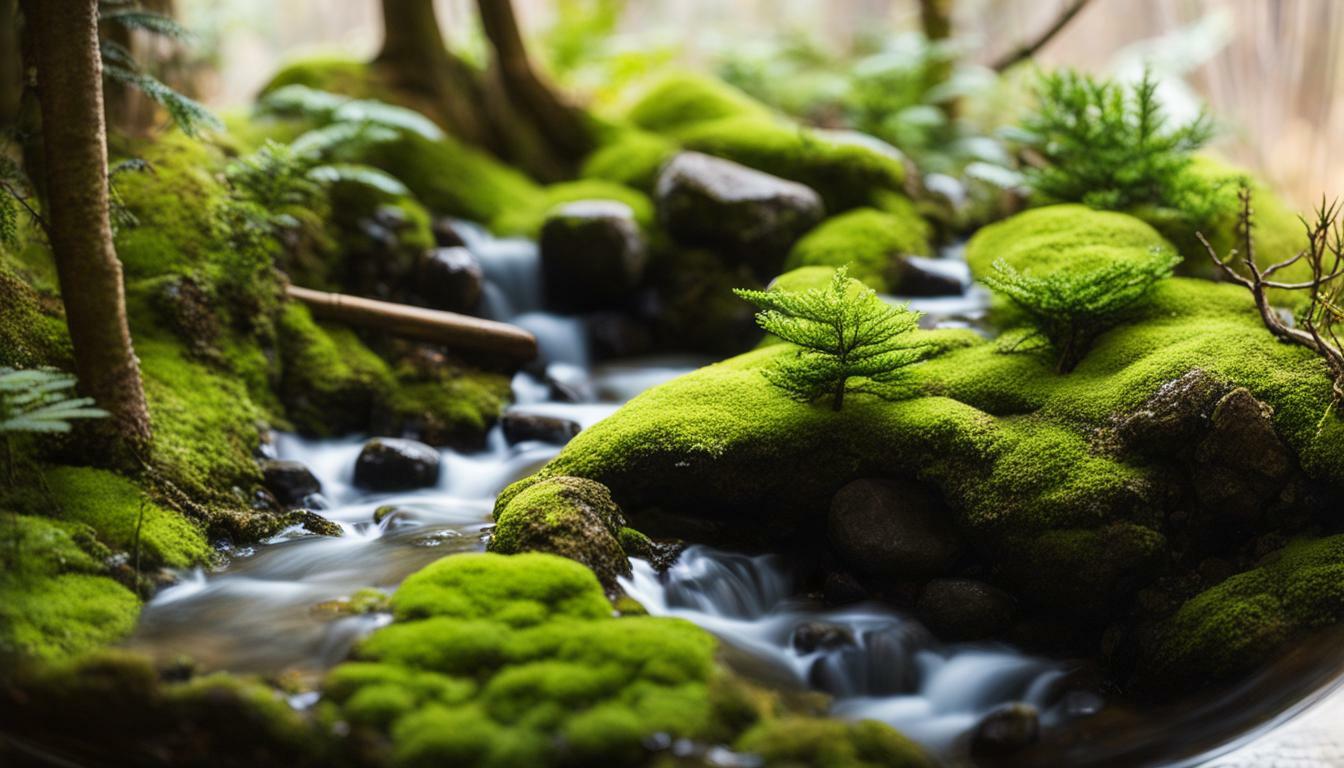Terrariums are captivating indoor gardens that are created in glass containers, making them perfect for those with limited space or a desire for low-maintenance greenery. These miniature gardens house self-sustaining plant ecosystems, providing a beautiful and tranquil environment to enjoy indoors. Whether you’re a seasoned plant lover or new to gardening, terrariums offer a unique and rewarding way to bring nature into your home.
Key Takeaways:
- Types of terrariums include closed and open terrariums.
- Closed terrariums function as miniature ecosystems, while open terrariums allow for the inclusion of arid plants.
- When choosing plants for your terrarium, consider their natural habitat, size, and growth rate.
- Recommended plants for terrariums include mosses, air plants, nerve plants, spiderwort, polka dot plants, maidenhair ferns, peace lilies, and snake plants.
- Water terrarium plants sparingly using a spray bottle and ensure optimal light and humidity levels for each plant.
Understanding Closed Terrariums
Closed terrariums are fully functioning ecosystems housed within glass containers, creating a self-sustaining environment for plants to grow and thrive. These miniature gardens have gained popularity among plant enthusiasts due to their low-maintenance nature and space-saving capabilities. With a closed terrarium, you can enjoy the beauty of nature indoors, even if you have limited space.
One of the key features of closed terrariums is their ability to create a self-sustaining environment. The glass container acts as a sealed ecosystem, allowing for the recycling of moisture and nutrients. The plants inside release moisture through transpiration, which then condenses on the glass walls and returns as water droplets to nourish the plants. This cycle creates a humid environment that is ideal for plants such as ferns, mosses, and tropical plants.
To set up a closed terrarium, you will need a glass container with a tight-fitting lid to ensure the ecosystem remains sealed. Choose plants that thrive in high humidity environments and have similar moisture and light requirements. It’s important to create layers within the terrarium, starting with a base layer of gravel or pebbles for drainage, followed by activated charcoal to filter the water, and then a layer of potting soil. Add your chosen plants, making sure to give them enough space to grow, and then seal the container. Place the terrarium in an area with indirect sunlight, as too much direct sunlight can cause overheating and condensation issues.
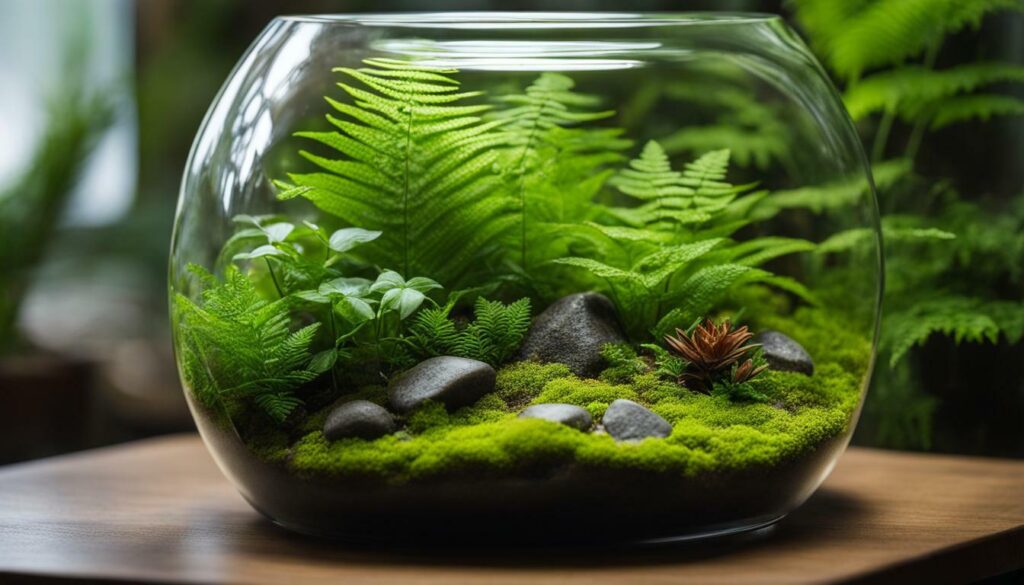
| Plant Name | Light Requirement | Watering Frequency |
|---|---|---|
| Maidenhair Fern | Indirect sunlight | Once a week |
| Moss | Low to medium light | When soil feels dry |
| Polka Dot Plant | Bright, indirect light | Regularly, keeping soil moist |
| Spiderwort | Indirect sunlight | Once a week |
In closed terrariums, it’s crucial to monitor the moisture levels to prevent overwatering. The sealed environment retains moisture, so only water the plants when the soil feels dry to the touch. Use a spray bottle to mist the plants, ensuring they receive a light, even coat of water. Overwatering can lead to root rot and the growth of mold or fungi.
With the right care and attention, closed terrariums can thrive for years, creating a captivating display of lush greenery in your indoor space. They provide a unique and self-sustaining ecosystem that allows you to observe the wonders of nature up close. So why not embrace this miniature garden trend and bring a touch of nature into your home with a closed terrarium?
Exploring Open Terrariums
Open terrariums provide a habitat for arid plants, allowing them to thrive in a controlled environment within the glass container. These types of terrariums are ideal for those who want to create a desert-like ecosystem in their homes. With proper care and attention, open terrariums can be a stunning addition to any space.
One of the main differences between open and closed terrariums is that open terrariums allow for more airflow, preventing excessive moisture buildup. This makes them perfect for arid plants that prefer a drier environment. Cacti and succulents, such as aloe vera and jade plants, are popular choices for open terrariums due to their ability to tolerate dry conditions.
When designing an open terrarium, it’s important to consider the needs of the plants you choose. Arid plants require well-draining soil to prevent root rot, so incorporating a layer of gravel or activated charcoal at the bottom of the container is essential. This layer helps to absorb excess moisture and provides a foundation for the plants to grow.
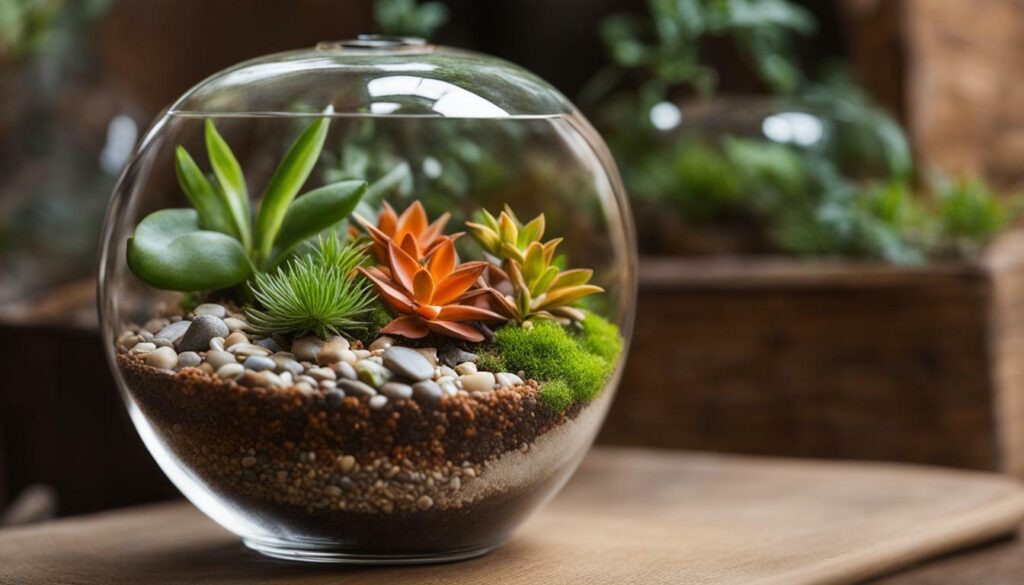
Creating a Beautiful Arid Landscape
To create a visually appealing open terrarium, consider incorporating a variety of textures and heights. Mix different types of arid plants, such as spiky cacti, trailing succulents, and small desert shrubs, to add interest and depth to the arrangement. Don’t be afraid to experiment with different colors and shapes to create a unique desert landscape.
Remember, while arid plants are more resilient to drought-like conditions, they still require some care. It’s important to water them sparingly, allowing the soil to dry out between waterings. Overwatering can lead to root rot and the death of the plants. Additionally, placing the open terrarium in a location with bright, indirect sunlight will ensure that the plants receive adequate light for their growth.
| Recommended Arid Plants for Open Terrariums | Characteristics |
|---|---|
| Moon Cactus (Gymnocalycium) | Colorful and unique, does not require much water |
| Aloe Vera | Healing properties, requires minimal watering |
| Snake Plant (Sansevieria) | Tolerates low light conditions, low maintenance |
| Jade Plant (Crassula ovata) | Drought-tolerant, symbolic of good luck and prosperity |
| Zebra Plant (Haworthia) | Unique striped pattern, prefers bright indirect light |
Open terrariums offer endless possibilities for creating miniature desert landscapes within your home. With the right choice of arid plants, proper care, and attention to detail, you can enjoy the beauty of these unique ecosystems year-round.
Choosing Plants for Your Terrarium
When choosing plants for your terrarium, it’s crucial to consider their natural habitat, size, and growth rate to create a balanced and thriving ecosystem. Terrariums are miniature gardens housed inside glass containers that create self-sustaining plant ecosystems. Whether you opt for a closed terrarium or an open one, selecting the right plants is essential for the success of your indoor garden.
One factor to consider is the natural habitat of the plants you choose. Different plant species thrive in varying environments, such as humid rainforests or dry desert regions. It’s important to match the plants’ natural habitat to the conditions within your terrarium. This will help ensure that the plants are able to adapt and flourish in their new micro-environment.
Another consideration is the size and growth rate of the plants. It’s crucial to choose plants that will complement each other in terms of size, ensuring that one doesn’t outgrow and overwhelm the others. Selecting plants with similar growth rates will help maintain a harmonious and visually appealing terrarium. Additionally, consider the overall size of your terrarium and choose plants accordingly. Opt for smaller, compact plants if you have a smaller terrarium, or select taller plants if you have a larger container.
Here is a table summarizing some recommended plants for terrariums:
| Plant | Size | Growth Rate |
|---|---|---|
| Mosses | Small | Slow |
| Air Plants | Small | Slow |
| Nerve Plants | Small | Medium |
| Spiderwort | Medium | Fast |
| Polka Dot Plants | Medium | Fast |
| Maidenhair Ferns | Medium | Medium |
| Peace Lilies | Tall | Medium |
| Snake Plants | Tall | Slow |
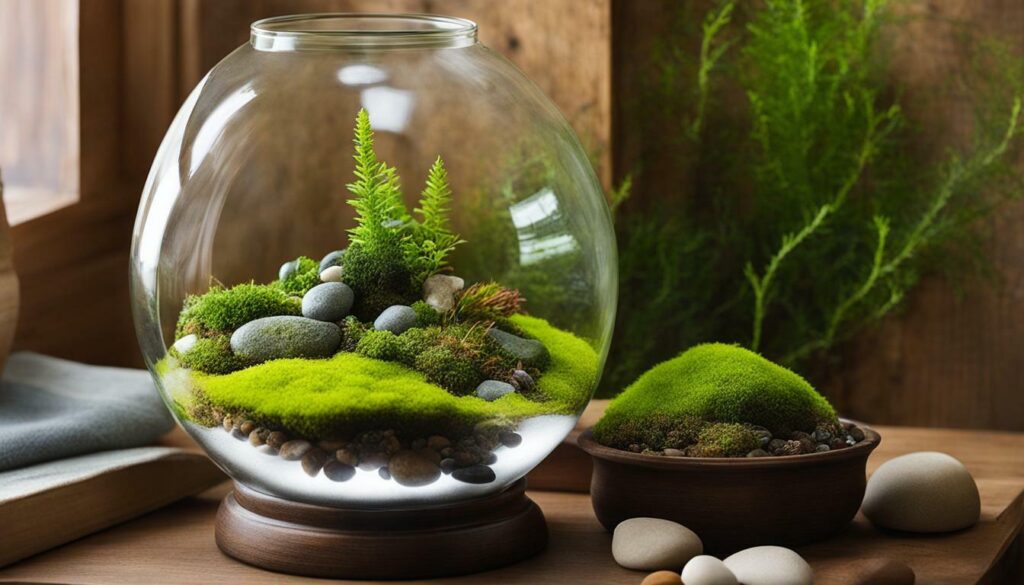
Choosing the right plants for your terrarium will contribute to its overall health and beauty. With the proper selection, you can create a mesmerizing and self-sustaining indoor garden. Remember to consider the plants’ natural habitat, size, and growth rate to ensure a harmonious and thriving ecosystem.
Recommended Plants for Terrariums
There is a wide variety of plant options for terrariums, including mosses, air plants, nerve plants, spiderwort, polka dot plants, maidenhair ferns, peace lilies, and snake plants, all of which thrive in the controlled environment of a terrarium. These plants have unique characteristics that make them ideal for creating beautiful and self-sustaining miniature gardens.
Mosses are excellent choices for terrariums due to their ability to retain moisture and create a lush green carpet. They provide a natural and organic look to the terrarium, adding depth and texture. Air plants, also known as tillandsias, are intriguing and low-maintenance plants that do not require soil. They can be attached to rocks or pieces of driftwood, creating a fascinating visual display.
Nerve plants, with their vibrant and intricate foliage, add a pop of color to any terrarium. They thrive in high humidity and diffuse light, making them perfect for this enclosed environment. Spiderwort is another striking choice, with its long, arching leaves and delicate flowers. It adds a touch of elegance and grace to the terrarium.
Polka dot plants are known for their colorful and patterned leaves, adding visual interest and variety to the terrarium. Maidenhair ferns, with their delicate and lacy fronds, bring a touch of elegance and sophistication. Peace lilies are not only beautiful but also help purify the air inside the terrarium, making them a beneficial addition to any indoor space. Finally, snake plants, with their upright and sword-shaped leaves, are hardy and easy to care for, making them perfect for beginners.
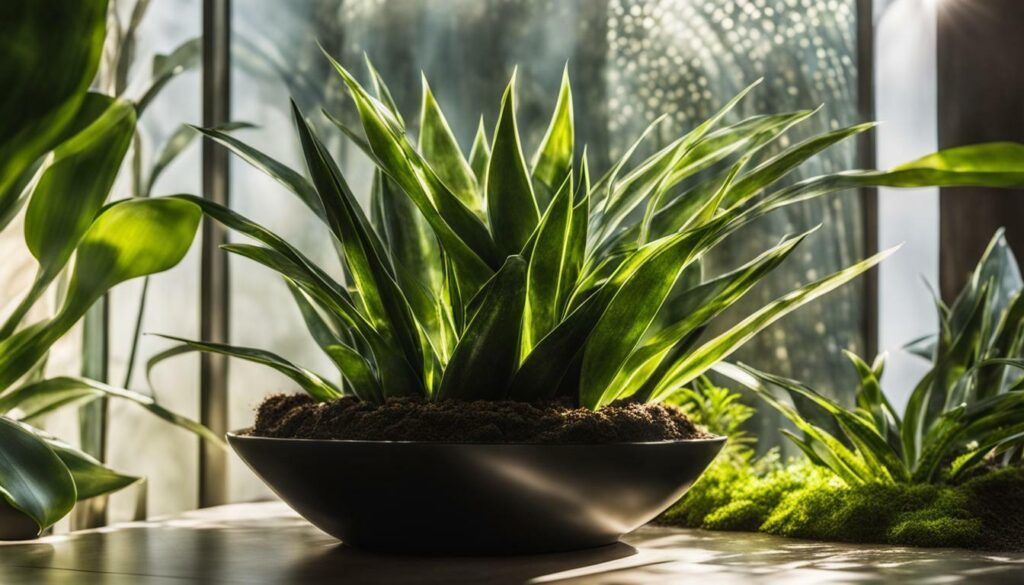
| Plant | Characteristics |
|---|---|
| Mosses | Retains moisture, creates lush green carpet |
| Air plants | No soil required, attached to rocks or driftwood |
| Nerve plants | Vibrant colors, thrives in high humidity |
| Spiderwort | Long, arching leaves, delicate flowers |
| Polka dot plants | Colorful and patterned leaves |
| Maidenhair ferns | Delicate and lacy fronds |
| Peace lilies | Beautiful and air-purifying |
| Snake plants | Hardy and easy to care for |
Caring for Terrarium Plants
Proper care of terrarium plants involves consistent and careful watering using a spray bottle, as well as ensuring the ideal light and humidity conditions for each plant species. The limited space within a terrarium requires a different approach to watering compared to traditional potted plants. Overwatering can lead to root rot and other issues, so it’s important to find the right balance.
Using a spray bottle is the best way to water terrarium plants. This allows for controlled and targeted watering, mimicking the gentle mist that plants would receive in their natural habitats. It is recommended to spray the plants sparingly, avoiding direct spraying onto the leaves or creating excessive moisture within the terrarium. Always monitor the moisture levels of the soil and adjust your watering routine accordingly.
Light and humidity levels are crucial for the well-being of terrarium plants. Most terrarium plants prefer bright, indirect light. Placing your terrarium near a window or providing artificial light sources can help create the optimal lighting conditions. Additionally, maintaining the right humidity levels is essential. This can be achieved by using a humidity tray, misting the plants occasionally, or choosing plants with similar humidity requirements.
Table: Recommended Light and Humidity Levels for Popular Terrarium Plants
| Plant | Light Requirements | Humidity Needs |
|---|---|---|
| Mosses | Low to medium light | High humidity |
| Air plants | Bright indirect light | Moderate to high humidity |
| Nerve plants | Medium to bright indirect light | High humidity |
| Spiderwort | Medium to bright indirect light | Medium to high humidity |
| Polka dot plants | Bright indirect light | High humidity |
| Maidenhair ferns | Medium to bright indirect light | High humidity |
| Peace lilies | Low to medium light | Medium to high humidity |
| Snake plants | Low to bright indirect light | Low to moderate humidity |
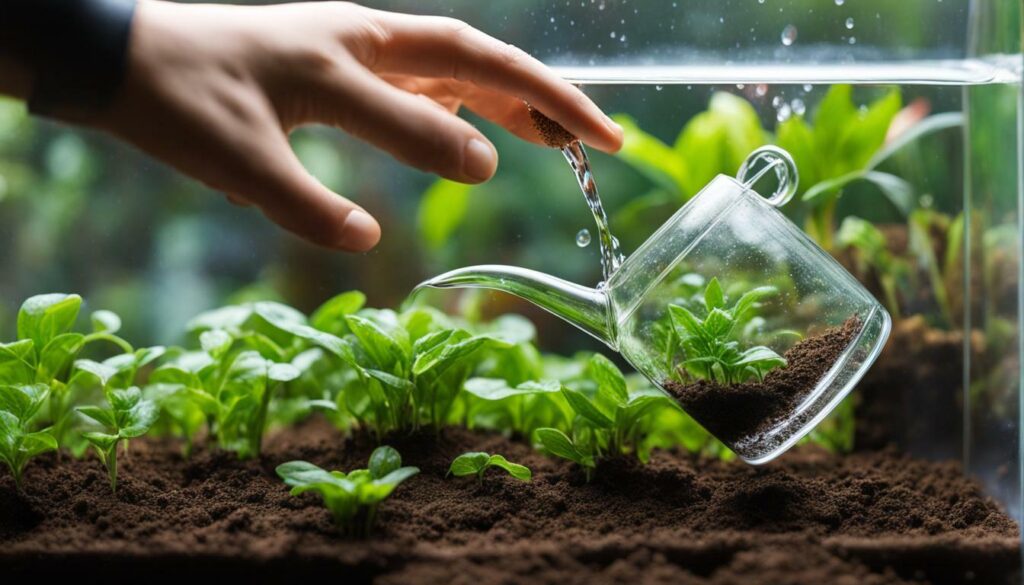
Remember to regularly monitor and adjust the lighting and humidity levels based on your specific terrarium setup. Each plant has unique requirements, so it’s essential to understand their individual needs and provide the optimal care to ensure their health and longevity in your terrarium.
Closed Terrarium Maintenance
Closed terrariums require specific maintenance to ensure the balance of moisture and prevent excessive condensation, as well as regular pruning to keep the plants healthy and maintain the desired aesthetic.
Condensation is a natural occurrence in closed terrariums due to the enclosed environment. While some condensation is necessary for the plants’ survival, excessive moisture can lead to the development of mold or rot. To manage condensation levels, it’s important to monitor the terrarium’s humidity and ventilation. If you notice an excessive build-up of moisture, you can gently wipe the inside of the glass with a clean cloth to help control the humidity. Additionally, opening the terrarium for a short period each day can help regulate moisture levels. This will allow fresh air to circulate and prevent the formation of mold.
Regular pruning is essential to keep the plants in your closed terrarium healthy and thriving. As the plants grow, they may start to touch the sides of the glass or each other, potentially hindering their growth. To maintain a visually appealing terrarium, carefully trim any overgrown or damaged leaves with sterilized pruning shears. Be sure to remove any dead or decaying plant material, as this can attract pests or cause the terrarium’s ecosystem to become imbalanced.
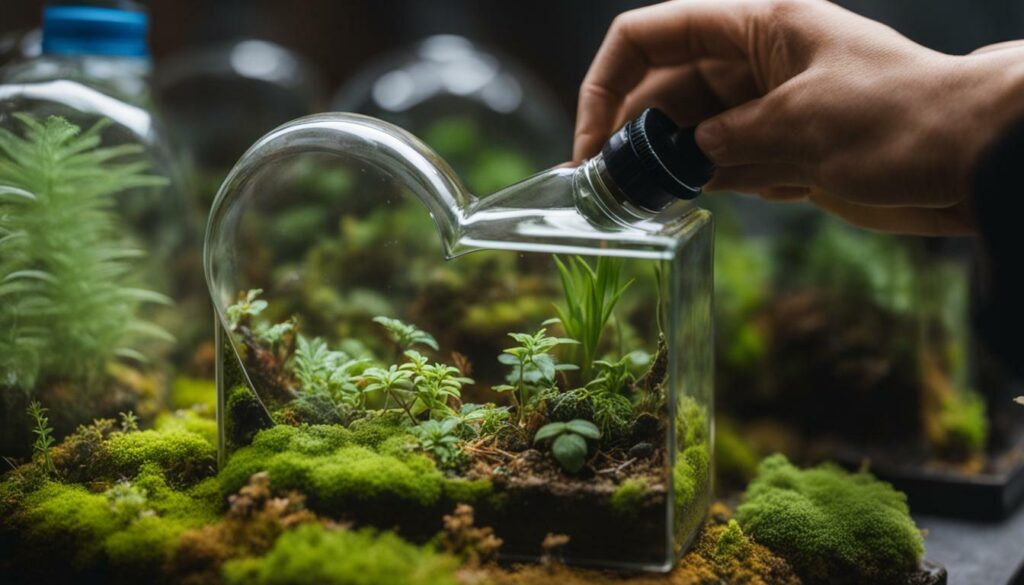
In summary, closed terrarium maintenance involves managing condensation levels and ensuring proper ventilation to prevent the growth of mold or rot. Additionally, regular pruning is necessary to maintain the health and aesthetic of the plants. By following these maintenance tips, you can create a thriving and visually stunning closed terrarium that will bring joy and greenery to your indoor space.
Open Terrarium Maintenance
Open terrariums require regular watering, careful monitoring of soil moisture, and effective pest control to maintain a thriving and visually appealing garden. Unlike closed terrariums, which create their own self-sustaining ecosystems, open terrariums rely on more active maintenance to ensure the health of the plants within.
When it comes to watering open terrariums, finding the right balance is crucial. Overwatering can lead to root rot and mold growth, while underwatering can cause plants to wither and die. It’s important to observe the moisture levels of the soil and only water when it feels dry to the touch. A good rule of thumb is to water moderately, allowing the soil to dry out slightly between waterings.
Pest control is another essential aspect of open terrarium maintenance. Since open terrariums are exposed to the surrounding environment, pests like aphids, mealybugs, and fungus gnats can find their way in. Regularly inspect the plants for any signs of infestation, such as yellowing leaves or tiny insects crawling on the foliage. In case of an infestation, natural remedies like neem oil or insecticidal soap can be used to control the pests.
Caring for Terrariums is a Delightful Task
Remember to place your open terrarium in a location that provides the appropriate amount of light for the plants it houses. Most terrarium plants thrive in bright, indirect light, so choose a spot near a window or utilize artificial lighting if needed. Additionally, keep an eye on the humidity levels, as some plants prefer higher humidity than others. Misting the leaves or placing a small tray of water near the terrarium can help maintain the desired moisture levels.
| Open Terrarium Maintenance | Watering Schedule | Pest Control |
|---|---|---|
| Regularly monitor soil moisture and water when dry | Water moderately, allowing soil to dry out slightly between waterings | Inspect plants for signs of pests and use natural remedies to control infestation |
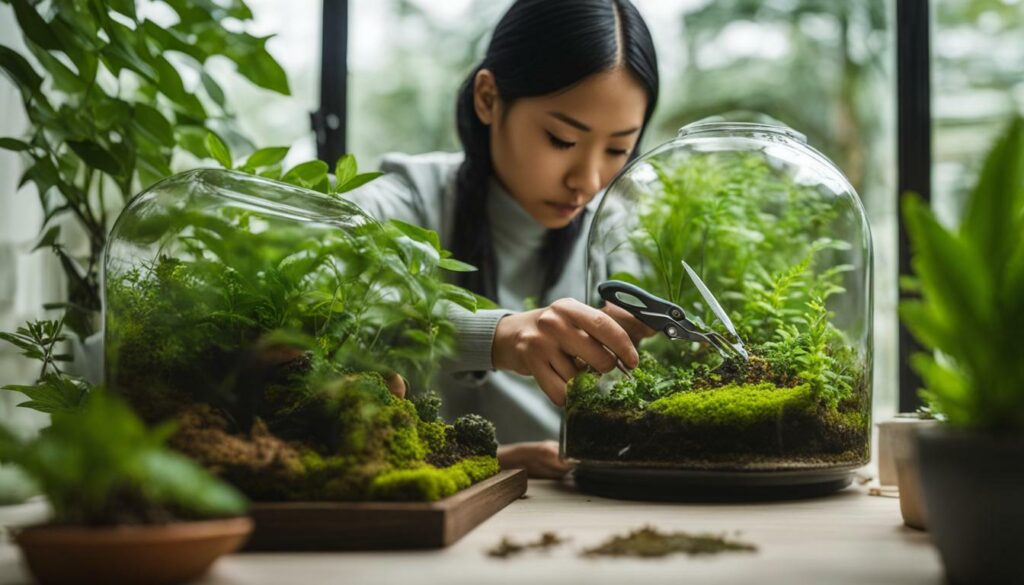
With proper care and attention to watering, pest control, light, and humidity, your open terrarium can thrive as a beautiful and captivating display of greenery in your home. Enjoy the process of tending to your terrarium and watching it flourish as a miniature garden.
Terrarium Placement and Display
Finding the right spot for your terrarium is essential to ensure the plants receive the proper amount of light for their specific needs while also considering its decorative potential. Light plays a crucial role in the growth and health of terrarium plants, and different species have varying light requirements. Placing your terrarium near a window with indirect sunlight is generally recommended, as direct sunlight can cause the glass to overheat and damage the plants inside.
Consider the natural habitat of the plants you have chosen for your terrarium. Some plants thrive in bright, indirect light, while others prefer lower light levels. Research the light requirements of your selected plant species and choose a spot that provides the appropriate amount of light.
In addition to lighting, you can enhance the aesthetic appeal of your terrarium by incorporating decorative elements. Add small figurines, stones, or colored glass pebbles to create visual interest and personalize your terrarium. Remember to maintain a harmonious balance between the plants and the decorative elements, ensuring that they do not overcrowd the limited space within the terrarium.
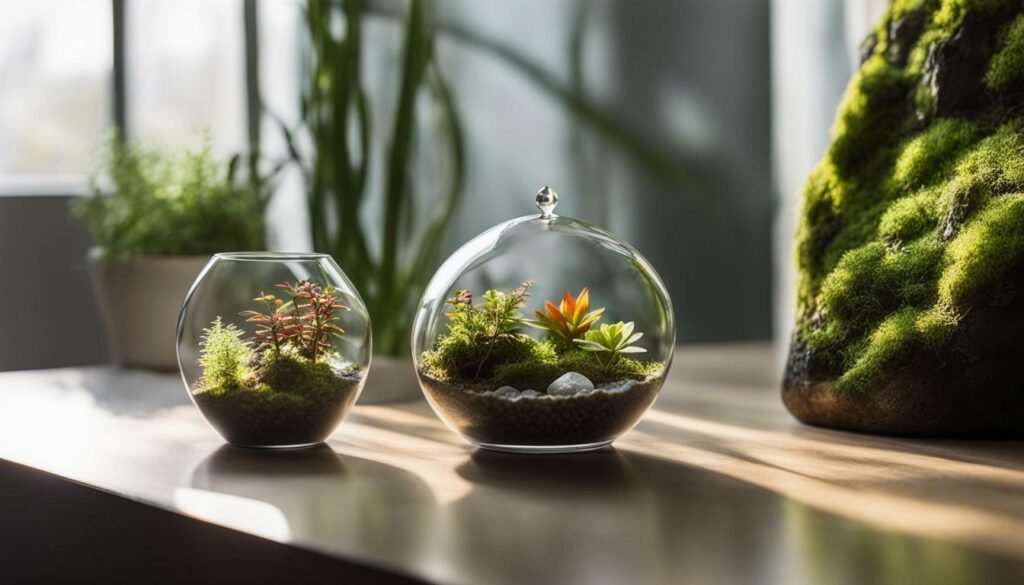
| Plant | Light Requirements |
|---|---|
| Mosses | Low to moderate light |
| Air plants | Bright, indirect light |
| Nerve plants | Medium to bright, indirect light |
| Spiderwort | Bright, indirect light |
| Polka dot plants | Medium to bright, indirect light |
| Maidenhair ferns | Medium to bright, indirect light |
| Peace lilies | Medium to bright, indirect light |
| Snake plants | Low to moderate light |
Remember to regularly observe your terrarium to ensure that the plants are thriving in their chosen spot. Adjust the placement if necessary to optimize their growth. With the right balance of light and decorative elements, your terrarium will not only be a beautiful addition to your home but also a thriving miniature garden.
Conclusion
Terrariums offer a unique and captivating way to bring the beauty of indoor gardens into any space, providing a low-maintenance and visually appealing option for plant enthusiasts. These miniature gardens housed inside glass containers create self-sustaining plant ecosystems that can thrive in even the smallest of spaces. Whether you have limited space, want to add a touch of greenery to your home, or simply enjoy the beauty of plants, terrariums are a wonderful choice.
When choosing a terrarium, you have the option of closed or open terrariums. Closed terrariums are fully functioning ecosystems, creating a self-sustaining environment for plants. Open terrariums, on the other hand, allow for the inclusion of arid plants, offering a different type of aesthetic and plant selection. Whichever type you choose, it’s important to consider the natural habitat, size, and growth rate of the plants you select to ensure a harmonious and sustainable terrarium.
Some recommended plants for terrariums include mosses, air plants, nerve plants, spiderwort, polka dot plants, maidenhair ferns, peace lilies, and snake plants. These plants are well-suited for the unique environment of a terrarium, thriving in the enclosed space and adding beauty and character to the display. When it comes to watering, terrarium plants should be watered sparingly using a spray bottle to maintain the right level of moisture. Additionally, it’s important to consider the ideal light and humidity levels for each type of plant to ensure their overall health and growth.
Finally, when it comes to placement and display, terrariums can be a versatile addition to any space. Consider the light requirements of your chosen plants and find a suitable spot that provides the right amount of natural or artificial light. You can also enhance the overall aesthetic appeal by incorporating decorative elements such as pebbles, figurines, or fairy lights. Get creative and let your terrarium become a unique expression of your personal style.
Overall, terrariums are a wonderful way to enjoy the beauty of indoor gardens, even in the smallest of spaces. With their low-maintenance nature and endless creative possibilities, they are sure to bring a touch of greenery and serenity to any environment. So why not create your own little oasis today?
How to Choose the Right Type of Terrarium for Different Types of Plants?
When selecting the right type of terrarium for your plants, consider the size and shape to accommodate different plant species. You can find a variety of inexpensive terrariums online that cater to the specific needs of your plants. Research the requirements of your plants and choose a terrarium that best fits their needs.
FAQ
What are terrariums?
Terrariums are miniature gardens housed inside glass containers that create self-sustaining plant ecosystems.
What types of terrariums are there?
There are two main types of terrariums: closed terrariums, which are fully functioning ecosystems, and open terrariums, which allow for the inclusion of arid plants.
How do closed terrariums work?
Closed terrariums function as miniature ecosystems, creating a self-sustaining environment for plants to thrive.
What plants are suitable for closed terrariums?
Mosses, air plants, nerve plants, spiderwort, polka dot plants, maidenhair ferns, peace lilies, and snake plants are recommended for closed terrariums.
What are open terrariums?
Open terrariums are terrariums that allow for the inclusion of arid plants, creating an environment suitable for these types of plants.
How should I choose plants for my terrarium?
When choosing plants for a terrarium, it’s important to consider their natural habitat, size, and growth rate to ensure a harmonious and sustainable terrarium.
What plants are recommended for terrariums?
Recommended plants for terrariums include mosses, air plants, nerve plants, spiderwort, polka dot plants, maidenhair ferns, peace lilies, and snake plants.
How should I care for terrarium plants?
Terrarium plants should be watered sparingly with a spray bottle, and the ideal light and humidity levels should be considered for each type of plant.
How do I maintain a closed terrarium?
Closed terrariums require managing condensation and occasional pruning to maintain a healthy and visually appealing terrarium.
How do I maintain an open terrarium?
Open terrariums require a regular watering schedule, pest control measures, and preventing the soil from drying out.
Where should I place and display my terrarium?
Terrariums should be placed in an area that meets the light requirements of the plants. Adding decorative elements can enhance the overall aesthetic appeal.

